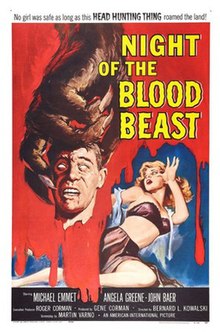Night of the Blood Beast
| Night of the Blood Beast | |
|---|---|
 |
|
| Directed by | Bernard L. Kowalski |
| Produced by |
Gene Corman Roger Corman |
| Screenplay by | Martin Varno |
| Story by | Martin Varno (uncredited on-screen; see WGA arbitration) Gene Corman (credited on-screen) |
| Starring | Michael Emmet Angela Greene John Baer Ed Nelson |
| Music by | Alexander Laszlo |
| Cinematography | John Mathew Nickolaus, Jr. |
| Edited by | Jodie Copelan |
| Distributed by | American International Pictures |
|
Release date
|
|
|
Running time
|
62 minutes |
| Country | United States |
| Language | English |
| Budget | $68,000 |
Night of the Blood Beast is a 1958 American science-fiction horror film about a team of scientists who are stalked by an alien creature, which implants its embryos in an astronaut's body during a space flight. Produced by exploitation filmmaker Roger Corman and his brother Gene, it was one of the first films directed by Bernard L. Kowalski and was written by first-time screenwriter Martin Varno, who was 21 years old. It starred several actors who had regularly worked with Roger Corman, including Michael Emmet, Ed Nelson, Steve Dunlap, Georgianna Carter and Tyler McVey. The film was theatrically released in Dec., 1958 on a double bill with She Gods of Shark Reef.
It took Varno six weeks to write the script, the original working title of which was Creature from Galaxy 27. The story was partially influenced by the real-life Space Race and the Howard Hawks film The Thing from Another World (1951). Screenwriters Jerome Bixby and Harold Jacob Smith gave Varno uncredited assistance with the dialogue. With a budget of about $68,000, it was shot over seven days at the Charlie Chaplin Studios, Bronson Canyon and a television station on Mount Lee in Hollywood.
The Blood Beast alien costume was also previously used in the Roger Corman film Teenage Caveman (1958), which was filmed just two weeks earlier. Art director Daniel Haller, who built the rocket-ship and other props, slept at the sound stage between work sessions. Following dissatisfaction with his treatment by the Cormans, Varno pursued two successful arbitration cases, one of which was for underpayment. The other was in response to Gene Corman's original story writing credit, even though Varno claimed to have written the entire story himself.
...
Wikipedia
